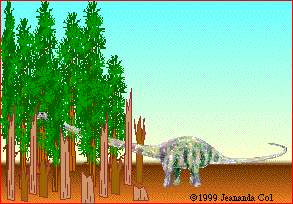
 |
| You might also like: | Cretaceous Plants - ZoomDinosaurs.com | Rainforest Strata | Today's featured page: Shapes - Beginning Readers Books |
| Triassic Plants | Jurassic Plants | Cretaceous Plants |
 Conifers (like Araucarioxylon) were the dominant land plant during the Jurassic period. Other land plants included Ginkgophytes (like Ginkgos), club mosses, horsetails, ferns, seed ferns, Sphenopsids (like Neocalamites), Filincophyta (like Matonidium), Cycadeodia (like Otozamites, Ptilophyllum, and Cycadeoidea), and cycadophytes.
Conifers (like Araucarioxylon) were the dominant land plant during the Jurassic period. Other land plants included Ginkgophytes (like Ginkgos), club mosses, horsetails, ferns, seed ferns, Sphenopsids (like Neocalamites), Filincophyta (like Matonidium), Cycadeodia (like Otozamites, Ptilophyllum, and Cycadeoidea), and cycadophytes.
Flowering plants evolved about 140 million years ago, during the late Jurassic period. This development would soon change the face of the Earth.
The many smaller and medium-sized dinosaurs that lived during this time, like Xiaosaurus, Dryosaurus, Kentrosaurus, and Stegosaurus, would have browsed on low-lying plants, like seed ferns, ferns, horsetails, club mosses, and low-lying conifers.
Horsetails were an important source of nutrition for plant-eating dinosaurs. These primitive vascular plants were fast-growing and resilient (they could propagate using underground runners which a grazing dinosaur wouldn't eat). This meant that a hungry dinosaur could eat the plant without killing it, since the plant would regrow from the rhizome (the underground stem). |
Williamsonia sewardiana was a cycadeoidphyte (a bennettitalean). It had a long, thin, woody stem and simple leaves. |
 There was no polar ice during the last two-thirds of the Jurassic. The climate was warm and moist and the sea levels high. There were vast flooded areas, temperate and subtropical forests, and coral reefs. The extensive water moderated the strong seasonality
There was no polar ice during the last two-thirds of the Jurassic. The climate was warm and moist and the sea levels high. There were vast flooded areas, temperate and subtropical forests, and coral reefs. The extensive water moderated the strong seasonality
| Triassic Plants | Jurassic Plants | Cretaceous Plants |
Enchanted Learning®
Over 35,000 Web Pages
Sample Pages for Prospective Subscribers, or click below
|
Overview of Site What's New Enchanted Learning Home Monthly Activity Calendar Books to Print Site Index K-3 Crafts K-3 Themes Little Explorers Picture dictionary PreK/K Activities Rebus Rhymes Stories Writing Cloze Activities Essay Topics Newspaper Writing Activities Parts of Speech Fiction The Test of Time
|
Biology Animal Printouts Biology Label Printouts Biomes Birds Butterflies Dinosaurs Food Chain Human Anatomy Mammals Plants Rainforests Sharks Whales Physical Sciences: K-12 Astronomy The Earth Geology Hurricanes Landforms Oceans Tsunami Volcano |
Languages Dutch French German Italian Japanese (Romaji) Portuguese Spanish Swedish Geography/History Explorers Flags Geography Inventors US History Other Topics Art and Artists Calendars College Finder Crafts Graphic Organizers Label Me! Printouts Math Music Word Wheels |
Click to read our Privacy Policy
| Search the Enchanted Learning website for: |